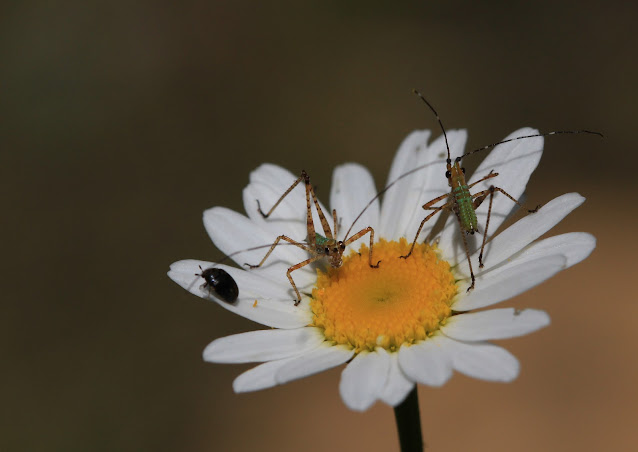 |
Two immature Orthopterans and a beetle hanging out on an ox-eye daisy. Not sure if these are grasshoppers or katydids, but due to the lack of fully formed wings, they are not adults.
|
Bugs. A word that can bring excitement to some, dread to others, and taxonomically misused all the time. (True Bugs are a specific group of insects, but I recognize that the word "bug" generally means insects, spiders, and other arthropods.) I love insects and most other arthropods (Except roaches. Just. No.) Insects especially are too amazing for words. The infinitesimal number of niches they fill, the adaptations they have and the sheer number of them constantly blow my mind. One thing I really love about them are their relationships with plants and vice versa. One of the most notable relationships occurs with insects who end up being pollinators of plants. Beyond that though, are insects eating plants, insects and other arthropods eating the insects that are eating the plants and so on. That is why I thought it would be fun to take a look at just a few instances of "bugs" on plants.
 |
| This one is an adult grasshopper, hanging out on a lovely blooming Liatris or blazing star. |
 |
| A harvestman lounging on pasture rose, Rosa carolina. |
 |
A scarab beetle, possibly in the genus, Trichiotinus, hanging out on some wild hydrangea flowers, Hydrangea arborenscens. These beetles feed on pollen and nectar as adults.
|
 |
| Looking about its universe, a soldier beetle in the family Cantharidae, perches on the end of a leaf. |
 |
| A dusky wing butterfly, Erynnis spp., probes for nectar with its long proboscis on downy wood mint, Blephilia ciliata. |
 |
| This juniper hairstreak's, Callophrys gryneus, striped antenna and legs sure are fancy! He's dressed to the nines for dining on rattle snake master flowers, Eryngium yuccifolium. |
 |
| A tiny moth named the mournful thyris, Thyris sepulchralis, sips nectar from a prairie plant in the genus, Zizia. |
 |
An even tinier moth, Spragueia apicalis, perches atop a gray headed coneflower, Ratibida pinnata, for its meal.
|
 |
Honing in on a prime Penstemon flower, a bumble bee, Bombus spp., comes in for a landing, tongue out and ready to get some nectar.
|
 |
| A gray headed coneflower, Ratibida pinnata, is producing lots of pollen which this small native bee is taking advantage of. |
 |
| Large and small, members of the order Hymenoptera (bees, wasps and ants) take advantage of the many tiny flowers that make up the head of a rattlesnake master plant, Eryngium yuccifolium. |
 |
| Awaiting a tasty snack such as a small bee, fly or beetle, this small crab spider in the family, Thomisidae, waits patiently on some just opening flowers of honewort, Cryptotaenia canadensis. |
 |
| Also hoping to catch and consume something for lunch is this silt bug, Neoneides spp. His reservations were on downy wood mint, Blephilia ciliata. |
Insects are other arthropods are one of only a few groups of animals that you can consistently see year round. And, they occur in every conceivable habitat including indoor spaces! This makes them accessible, entertaining, educational and more. Try looking around where you are for some 6 or more legged friends. You may be surprised at what you find!
Posted by: Robyn Wright-Strauss













